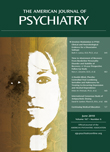To the Editor: We agree that differences in the rates of comorbid disorders in parents with bipolar disorder in existing studies may be accounted for by methodological differences. Many of the existing studies recruited parents exclusively from clinical settings, but to improve generalizability, in the BIOS trial we also recruited parents through advertisement (
1). These subjects were directly interviewed using standardized instruments, and the final diagnoses were made after consensus with psychiatrists. The referenced high-risk studies did not report the rates of comorbid disorders in parents and whether these rates corresponded to current or lifetime disorders. However, rates of lifetime comorbid disorders in parents with bipolar disorder in our study were similar to the rates reported in adults with bipolar disorder (
2).
Instead of only recruiting well co-parents, approximately 40% of the biological co-parents of offspring of parents with bipolar disorder and 25% of the co-parents of offspring of comparison subjects included in our study had psychopathology. Thus, we were able to evaluate the effects of co-parents' disorders on the children's psychopathology.
Dr. Duffy et al. note that other studies did not report elevated rates of ADHD in high-risk children. However, the studies they cite only included school-age offspring and not preschoolers. Of note, the BIOS trial also found that among school-aged children, after controlling for potential confounding factors, the rates of ADHD did not differ between offspring of parents with bipolar disorder and offspring of community comparison subjects (
1).
The fact that the caregiver/teachers could not differentiate between high-risk and comparison offspring in the BIOS trial does not prove or disprove the reliability of our study because, as expected, the sample size of preschool children who had caregiver/teacher reports was small (N=51). Moreover, of these children, only eight had a disruptive disorder. Recent analyses showed that relative to healthy children, these eight children had significantly higher attention and externalizing scores, but these results need to be replicated in larger samples.
We agree that very little is known about bipolar disorder in preschoolers. Therefore, at the request of parents with bipolar disorder who participated in our school-age study (
1), we decided to evaluate their preschool children for psychopathology, including the presence of DSM manic symptoms. After adjusting for several confounding factors (e.g., the child's ADHD symptoms), offspring of parents with bipolar disorder had significantly higher total scores on the Mania Rating Scale relative to offspring of comparison parents. Additionally, in adjusting for multiple comparisons, exploratory analyses showed that between-group differences in manic symptoms were mainly attributable to irritability, elation, decreased need for sleep, and mood lability. However, 96% of the severity scores for manic symptoms were classified as mild or less. Interestingly, these subclinical manic symptoms are similar to the prodromal manic symptoms retrospectively reported in the Amish study. We are in the process of following the children to evaluate the nature of these symptoms and whether they predict an increased risk for mood disorders.

